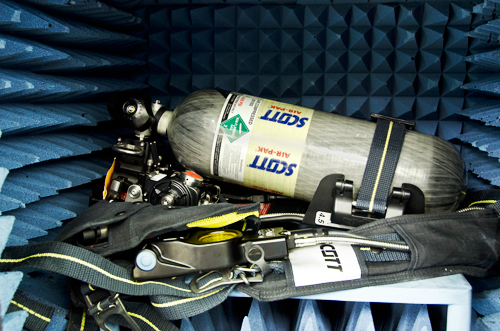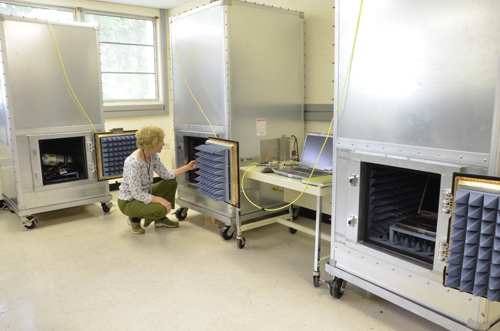New high standards for emergency wireless devices

First responders rely increasingly on wireless communication devices, and in emergencies they cannot afford major signal loss or delay caused by attenuation, interference, or reflection. Because lives are on the line and every second counts, the development of high-performance, high-reliability devices that meet widely accepted performance standards is a high priority.
"The key issue in public safety communication systems," says Kate Remley, leader of the Radio-Frequency Fields Group's Metrology for Wireless Systems Project, "is that personnel need their equipment to operate at a very high standard. They can't fail and reconnect the call like your cell phone might. That just won't do. So we have to develop new types of test methods that will verify the performance of the equipment in really rugged situations."
So for many years, researchers in PML's Electromagnetics Divisionhave worked with the National Fire Protection Association (NFPA) – which sets the industry standards for the field – to develop test methods that can verify the performance of wireless public safety devices such as Personal Alert Safety Systems (PASS). Portable PASS units contain a transmitter that sends a "firefighter-down" signal back to a base station when a firefighter remains motionless for 30 seconds.
Now the PML-developed test methods for point-to-point signal attenuation – as well as for interference effects between PASS units and wireless devices that operate in the same frequency bands, such as radio-frequency identification (RFID) systems – have been approved for the proposed 2013 revision of NFPA's PASS standard. The NFPA will vote on whether to adopt the revised standard in October, 2012. If it does, it will be the first time that new RF technology is included in the NFPA standard, and will likely pave the way for development of future RF devices.
Attenuation, or path loss, is an enormous problem in a range of firefighter environments. Low attenuation is experienced when the signal must travel through only a few walls (e.g., in a home, small office building, or even a skyscraper with a small footprint) before reaching the base station. But many emergency situations require signals from a portable PASS unit to travel through many thick walls and dense material which produce high attenuation.
The performance tests are conducted using a system of separate anechoic chambers: one houses the portable PASS unit mounted on a typical backpack-type air supply; the other contains the base receiver station. The portable unit transmits its signal from within the first chamber. The signal is picked up by an antenna in that chamber and transmitted through a coaxial cable to a broadcast antenna in the second chamber where the base station picks up the signal. Test operators can introduce precise amounts of attenuation and/or interference into the system. The process is fully controllable while also effectively simulating conditions in the field.

Data from extensive NIST field tests were used to calibrate the settings for the anechoic chambers. The researchers measured signal transfer through buildings, skyscrapers, convention centers, tunnels, the New York City subway system, and collapsed buildings.
"If you're buried in [a building] you want your beacon to be able to be received through a pile of rubble," says Remley. "But how much attenuation is that, exactly? No one really had data for that before NIST took these sets of measurements."
PASS communications often use "two-leg" transmission when a firefighter goes deep into a building, tunnel, or underground site to mitigate attenuation. The portable unit sends a signal to a stationary repeater unit—placed, for example, at the entrance to a tunnel—which then sends a signal to the base station.
To test those systems, Remley's project is developing a "single-hop" attenuation test. The PASS unit, repeater, and base station are placed in three separate anechoic chambers which are connected to one another via cable, and appropriate amounts of attenuation (based on field test data) are introduced between the chambers for each hop.
Interference effects have been measured using similar methods. The PASS signals are typically generated in the unlicensed radio spectrum in the 900 MHz band or 2.4 GHz band, both of which are used by many consumer wireless devices including home wireless devices and RFID systems. These devices can interfere with PASS performance. "We need to be able to verify that their equipment will work in the presence of all these other devices," Remley says. Interference from extraneous signals in the same frequency band is fed into the chamber through one side of a power divider that is connected to the anechoic chamber.
Wireless transmitters also contend with reflections off of metallic surfaces in an environment, and the researchers have begun to devise test methods for that, too. To replicate conditions in complex reflective environments, devices are put into isolated reverberation chambers. RF absorbers may be placed in the chamber to tailor the amount of reflection.
One- and two-hop attenuation tests and tests involving both hops and reflection are being developed now. Tests such as these will be useful to the Fire Department of New York, for example, which is often called into the subways where the attenuation is high and trains and tracks can cause reflection.
These test methods could also be used to test urban search and rescue robots which depend on wireless relay of video feed and commands, as well as for tests of wireless medical devices, and even consumer products. The anechoic chamber system is comparatively inexpensive and uncomplicated, and can accommodate devices that operate with different form factors and frequencies.
"Once we get the procedure, the parameters and the configurations all worked out," Remley says, "we'll have a very nice, general set of test methods that could be used for hand-held radios, or RFIDs, or medical or whatever kind of wireless equipment."
Provided by National Institute of Standards and Technology


















